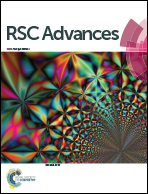New (1 − x)K0.5Na0.5NbO3–x(0.15Bi0.5Na0.5TiO3–0.85Bi0.5Na0.5ZrO3) ternary lead-free ceramics: microstructure and electrical properties
Abstract
Lead-free piezoelectric ceramics have attracted considerable attention owing to their environmental friendliness and good electrical properties. Here the new (1 − x)K0.5Na0.5NbO3–x(0.15Bi0.5Na0.5TiO3–0.85Bi0.5Na0.5ZrO3) [(1 − x)KNN–x(BNT–BNZ)] ternary lead-free piezoelectric ceramics synthesized by conventional solid sintering method are reported. The microstructure and electrical properties of (1 − x)KNN–x(BNT–BNZ) ternary ceramics were systematically investigated, and the ceramics with x = 0.06 possess enhanced piezoelectric properties and a high TC (e.g., d33 ∼ 318 pC N−1, kp ∼ 0.43, and TC ∼ 326 °C), which are mainly ascribed to the R–T phase boundary involved. It is believed that, such a ceramic system is a promising candidate in the field of lead-free piezoelectric ceramics.


 Please wait while we load your content...
Please wait while we load your content...